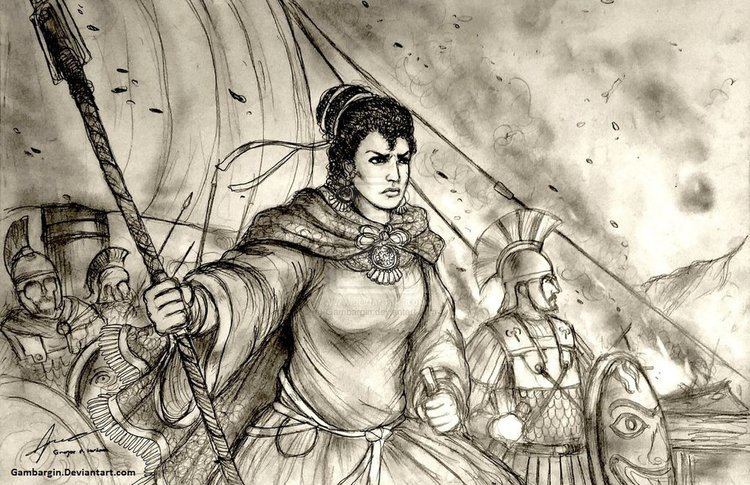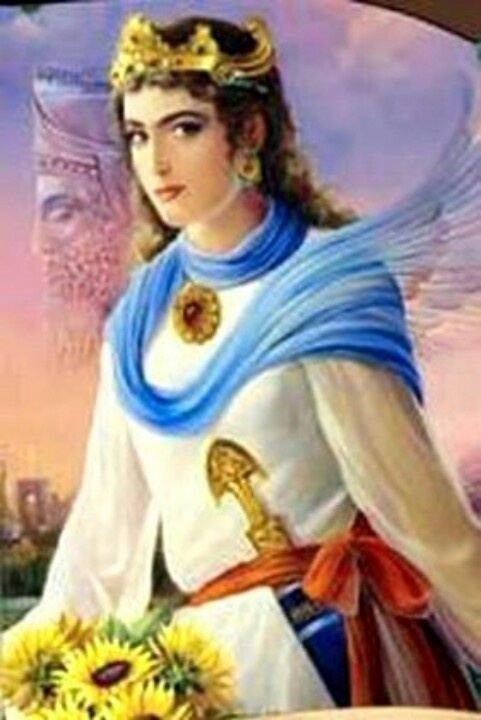Died 5th century BCE Greek: Ἀρτεμισία Mother Unknown Successor Pisindelis Grandchild Lygdamis II | Issue Pisindelis Father Lygdamis (Λύγδαμις) Parents Lygdamis I Children Pisindelis | |
 | ||
Predecessor Her husband (name unknown) Similar Themistocles, Xerxes I, Sullivan Stapleton, Mausolus, Eva Green | ||
Artemisia I of Caria (Ancient Greek: Ἀρτεμισία; Persian: آرتمیس; fl. 480 BCE) was queen of the ancient Greek city-state of Halicarnassus and of the nearby island of Kos, within the Achaemenid satrapy of Caria, in about 480 BCE. She fought as an ally of Xerxes I, King of Persia against the independent Greek city states during the second Persian invasion of Greece. She personally commanded her contribution of five ships at the naval battle of Artemisium and in the naval Battle of Salamis in 480 BCE. She is mostly known through the writings of Herodotus, himself a native of Halicarnassus, who praises her courage and the respect in which Xerxes held her.
Contents
Family and name

Artemisia's father was the satrap of Halicarnassus, Lygdamis I (Λύγδαμις Α') and her mother was from the island of Crete. She took the throne after the death of her husband, as she had a son, named Pisindelis (Πισίνδηλις), who was still a youth. Artemisia's grandson, Lygdamis II (Λύγδαμις Β'), was the satrap of Halicarnassus when Herodotus was exiled from there and the poet Panyasis (Πανύασις) was sentenced to death, after the unsuccessful uprising against him.

The name Artemisia derives from Artemis (n, f.; Roman equivalent: Diana), itself of unknown origin and etymology although various ones have been proposed; for example according to Jablonski, the name is also Phrygian and could be "compared with the royal appellation Artemas of Xenophon; according to Charles Anthon the primitive root of the name is probably of Persian origin from arta*, art*, arte*,.. all meaning great, excellent, holy,.. thus Artemis "becomes identical with the great mother of Nature, even as she was worshipped at Ephesus"; Anton Goebel "suggests the root στρατ or ῥατ, "to shake," and makes Artemis mean the thrower of the dart or the shooter"; Plato, in Cratylus, had derived the name of the Goddess from the Greek word ἀρτεμής, artemḗs, i.e. "safe", "unharmed", "uninjured", "pure", "the stainless maiden"; Babiniotis while accepting that the etymology is unknown, states that the name is already attested in Mycenean Greek and is possibly of pre-Hellenic origin.
Battle of Salamis

Xerxes was induced by the message of Themistocles to attack the Greek fleet under unfavourable conditions, rather than sending a part of his ships to the Peloponnesus and awaiting the dissolution of the Greek armies. Artemisia was the only one of Xerxes' naval commanders to advise against the action, then went on to earn her king's praise for her leadership in action during his fleet's defeat by the Greeks at the Battle of Salamis (September, 480 BCE).
Preparations
Before the battle of Salamis, Xerxes gathered all his naval commanders and sent Mardonios to ask whether or not he should fight a naval battle. All the commanders advised him to fight a naval battle except Artemisia.
As Herodotus tells it, she told Mardonios:
Tell the King to spare his ships and not do a naval battle because our enemies are much stronger than us in the sea, as men are to women. And why does he need to risk a naval battle? Athens for which he did undertake this expedition is his and the rest of Greece too. No man can stand against him and they who once resisted, were destroyed.
If Xerxes chose not to rush into a naval encounter, but instead kept his ships close to the shore and either stayed there or moved them towards the Peloponnese, victory would be his. The Greeks can't hold out against him for very long. They will leave for their cities, because they don't have food in store on this island, as I have learned, and when our army will march against the Peloponnese they who have come from there will become worried and they will not stay here to fight to defend Athens.
Xerxes was pleased with her advice and while he already held her in great esteem he now praised her further. Despite this, he gave orders to follow the advice of the rest of his commanders. Xerxes thought that at the naval battle of Artemisium his men acted like cowards because he was not there to watch them. But this time he would watch the battle himself to ensure they would act bravely.
Battle
Artemisia participated in the Battle of Salamis in September, 480 BCE as a Persian ally. She led the forces of Halicarnassos, Cos, Nisyros and Calyndos (Κάλυνδος) (Calyndos was on the southwest coast of Asia Minor across Rhodes), and supplied five ships. The ships she brought had the second best reputation in the whole fleet, next to the ones from Sidon.
As Herodotus says, during the battle, and while the Persian fleet was facing defeat, an Athenian ship pursued Artemisia's ship and she was not able to escape, because in front of her were friendly ships. She decided to charge against a friendly ship manned by people of Calyndos and on which the king of the Calyndians Damasithymos (Δαμασίθυμος) was located. The Calyndian ship sank. Herodotus also mentions that Artemisia had previously had a disagreement with Damasithymos at the Hellespont.
According to Polyaenus, when Artemisia saw that she was near to falling into the hands of the Greeks, she ordered the Persian colours to be taken down, and the master of the ship to bear down upon and attack a Persian vessel of the Calyndian allies, which was commanded by Damasithymus, that was passing by her.
When the captain of the Athenian ship, Ameinias, saw her charge against a Persian ship, he turned his ship away and went after others, supposing that the ship of Artemisia was either a Greek ship or was deserting from the Persians and fighting for the Greeks.
Herodotus believed that Ameinias didn't know that Artemisia was on the ship, because otherwise he would not have ceased his pursuit until either he had captured her or had been captured himself, because "orders had been given to the Athenian captains, and moreover a prize was offered of ten thousand drachmas for the man who should take her alive; since they thought it intolerable that a woman should make an expedition against Athens."
Polyaenus in his work Stratagems says that Artemisia had in her ship two different standards. When she chased a Greek ship, she hoisted the Persian colours. But when she was chased by a Greek ship, she hoisted the Greek colours, so that the enemy might mistake her for a Greek and give up the pursuit.
While Xerxes was overseeing the battle from his throne, which was at the foot of Mount Aigaleo, he observed the incident and he and the others who were present thought that Artemisia had attacked and sunk a Greek ship. One of the men who was next to Xerxes said to him: "Master, see Artemisia, how well she is fighting, and how she sank even now a ship of the enemy" and Xerxes then responded: "My men have become women; and my women, men.". None of the crew of the Calyndian ship survived to be able to accuse her otherwise. According to Polyaenus, when Xerxes saw her sink the ship, he said: "O Zeus, surely you have formed women out of man's materials, and men out of woman's.".
Aftermath
Plutarch, in his biography of Themistocles, says that it was Artemisia who recognised the body of Ariamenes (Ἀριαμένης) (Herodotus says that his name was Ariabignes), brother of Xerxes and admiral of the Persian navy, floating amongst the shipwrecks, and brought the body back to Xerxes.
After the Battle of Salamis
After the battle, according to Polyaenus, Xerxes acknowledged her to have excelled above all the officers in the fleet and sent her a complete suit of Greek armour and he presented the captain of her ship with a distaff and spindle.
According to Herodotus, after the defeat, Xerxes presented Artemisia with two possible courses of action and asked her which she recommended. Either he would lead troops to the Peloponnese himself, or he would withdraw from Greece and leave his general Mardonius in charge. Artemisia suggested to him that he should retreat back to Asia Minor and she advocated the plan suggested by Mardonius, who requested 300,000 Persian soldiers with which he would defeat the Greeks in Xerxes' absence.
According to Herodotus she replied: "I think that you should retire and leave Mardonius behind with those whom he desires to have. If he succeeds, the honour will be yours because your slaves performed it. If on the other hand, he fails, it would be no great matter as you would be safe and no danger threatens anything that concerns your house. And while you will be safe the Greeks will have to pass through many difficulties for their own existence. In addition, if Mardonius were to suffer a disaster who would care? He is just your slave and the Greeks will have but a poor triumph. As for yourself, you will be going home with the object for your campaign accomplished, for you have burnt Athens".
Xerxes followed her advice, leaving Mardonius to conduct the war in Greece. He sent her to Ephesus to take care of his illegitimate sons. In return, Artemisia's lands did well by their alliance with the Persians.
Opinions about Artemisia
Herodotus had a favourable opinion of Artemisia, despite her support of Persia and praises her decisiveness and intelligence and emphasises her influence on Xerxes.
Polyaenus says that Xerxes praised her gallantry. He also in the eighth book of his work Stratagems, mentions that when Artemisia (he may have referred to Artemisia I, but most probably he referred to Artemisia II) wanted to conquer Latmus, she placed soldiers in ambush near the city and she, with women, eunuchs and musicians, celebrated a sacrifice at the grove of the Mother of the Gods, which was about seven stades distant from the city. When the inhabitants of Latmus came out to see the magnificent procession, the soldiers entered the city and took possession of it.
On the other hand, Thessalus, a son of Hippocrates, describes her in a speech as a cowardly pirate. In his speech, Thessalus said that the King of Persia demanded earth and water from Coans but they refused (493 BCE) so he gave the island to Artemisia to be wasted. Artemisia led a fleet of ships to the island of Cos to hunt down and slaughter the Coans, but the gods intervened. After Artemisia's ships were destroyed by lightning and she hallucinated visions of great heroes, she fled Cos, but afterwards she conquered the island.
Death and cultural depictions in ancient world
A legend, quoted by Photius, some 13 centuries later, claims that Artemisia fell in love with a man from Abydos (Ancient Greek: Ἄβῡδος), named Dardanus (Greek: Δάρδανος), and when he ignored her, she blinded him while he was sleeping, but her love for him increased. An oracle told her to jump from the top of the rock of Leucas, but she was killed after she jumped from the rock and buried near the spot. Those who leapt from this rock were said to be cured from the passion of love. According to a legend, Sappho killed herself jumping from these cliffs too, because she was in love with Phaon.
Aristophanes mentions Artemisia in his works Lysistrata and Thesmophoriazusae.
Pausanias, in the third book of his work Description of Greece, entitled Laconia mentions that in the marketplace of Sparta the most striking monument was the portico which they called Persian, because it was made from spoils taken in the Persian wars. In course of time they have altered it until it became very large and splendid. On the pillars were white-marble figures of Persians, including Mardonius. There was also a figure of Artemisia.
